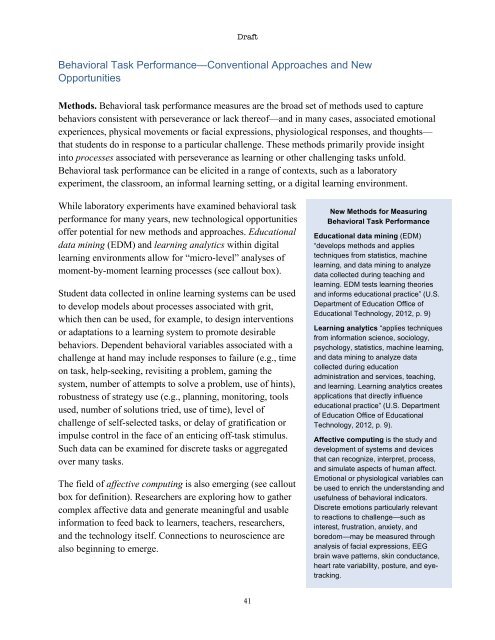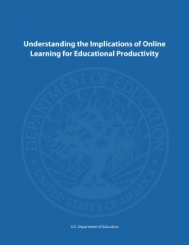Promoting Grit, Tenacity, and Perseverance - U.S. Department of ...
Promoting Grit, Tenacity, and Perseverance - U.S. Department of ...
Promoting Grit, Tenacity, and Perseverance - U.S. Department of ...
You also want an ePaper? Increase the reach of your titles
YUMPU automatically turns print PDFs into web optimized ePapers that Google loves.
Draft<br />
Behavioral Task Performance—Conventional Approaches <strong>and</strong> New<br />
Opportunities<br />
Methods. Behavioral task performance measures are the broad set <strong>of</strong> methods used to capture<br />
behaviors consistent with perseverance or lack there<strong>of</strong>—<strong>and</strong> in many cases, associated emotional<br />
experiences, physical movements or facial expressions, physiological responses, <strong>and</strong> thoughts—<br />
that students do in response to a particular challenge. These methods primarily provide insight<br />
into processes associated with perseverance as learning or other challenging tasks unfold.<br />
Behavioral task performance can be elicited in a range <strong>of</strong> contexts, such as a laboratory<br />
experiment, the classroom, an informal learning setting, or a digital learning environment.<br />
While laboratory experiments have examined behavioral task<br />
performance for many years, new technological opportunities<br />
<strong>of</strong>fer potential for new methods <strong>and</strong> approaches. Educational<br />
data mining (EDM) <strong>and</strong> learning analytics within digital<br />
learning environments allow for “micro-level” analyses <strong>of</strong><br />
moment-by-moment learning processes (see callout box).<br />
Student data collected in online learning systems can be used<br />
to develop models about processes associated with grit,<br />
which then can be used, for example, to design interventions<br />
or adaptations to a learning system to promote desirable<br />
behaviors. Dependent behavioral variables associated with a<br />
challenge at h<strong>and</strong> may include responses to failure (e.g., time<br />
on task, help-seeking, revisiting a problem, gaming the<br />
system, number <strong>of</strong> attempts to solve a problem, use <strong>of</strong> hints),<br />
robustness <strong>of</strong> strategy use (e.g., planning, monitoring, tools<br />
used, number <strong>of</strong> solutions tried, use <strong>of</strong> time), level <strong>of</strong><br />
challenge <strong>of</strong> self-selected tasks, or delay <strong>of</strong> gratification or<br />
impulse control in the face <strong>of</strong> an enticing <strong>of</strong>f-task stimulus.<br />
Such data can be examined for discrete tasks or aggregated<br />
over many tasks.<br />
The field <strong>of</strong> affective computing is also emerging (see callout<br />
box for definition). Researchers are exploring how to gather<br />
complex affective data <strong>and</strong> generate meaningful <strong>and</strong> usable<br />
information to feed back to learners, teachers, researchers,<br />
<strong>and</strong> the technology itself. Connections to neuroscience are<br />
also beginning to emerge.<br />
New Methods for Measuring<br />
Behavioral Task Performance<br />
Educational data mining (EDM)<br />
“develops methods <strong>and</strong> applies<br />
techniques from statistics, machine<br />
learning, <strong>and</strong> data mining to analyze<br />
data collected during teaching <strong>and</strong><br />
learning. EDM tests learning theories<br />
<strong>and</strong> informs educational practice” (U.S.<br />
<strong>Department</strong> <strong>of</strong> Education Office <strong>of</strong><br />
Educational Technology, 2012, p. 9)<br />
Learning analytics “applies techniques<br />
from information science, sociology,<br />
psychology, statistics, machine learning,<br />
<strong>and</strong> data mining to analyze data<br />
collected during education<br />
administration <strong>and</strong> services, teaching,<br />
<strong>and</strong> learning. Learning analytics creates<br />
applications that directly influence<br />
educational practice” (U.S. <strong>Department</strong><br />
<strong>of</strong> Education Office <strong>of</strong> Educational<br />
Technology, 2012, p. 9).<br />
Affective computing is the study <strong>and</strong><br />
development <strong>of</strong> systems <strong>and</strong> devices<br />
that can recognize, interpret, process,<br />
<strong>and</strong> simulate aspects <strong>of</strong> human affect.<br />
Emotional or physiological variables can<br />
be used to enrich the underst<strong>and</strong>ing <strong>and</strong><br />
usefulness <strong>of</strong> behavioral indicators.<br />
Discrete emotions particularly relevant<br />
to reactions to challenge—such as<br />
interest, frustration, anxiety, <strong>and</strong><br />
boredom—may be measured through<br />
analysis <strong>of</strong> facial expressions, EEG<br />
brain wave patterns, skin conductance,<br />
heart rate variability, posture, <strong>and</strong> eyetracking.<br />
41
















